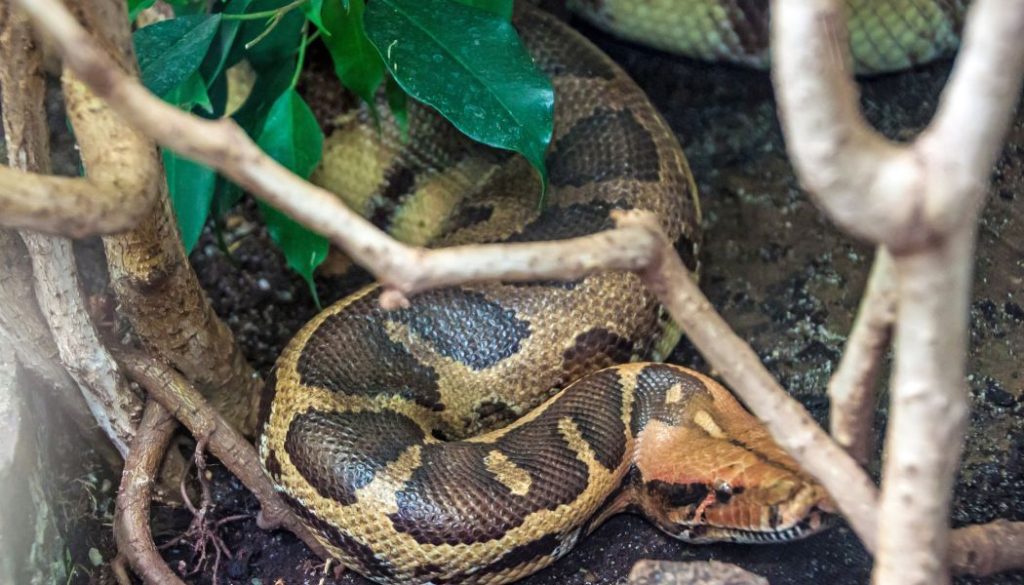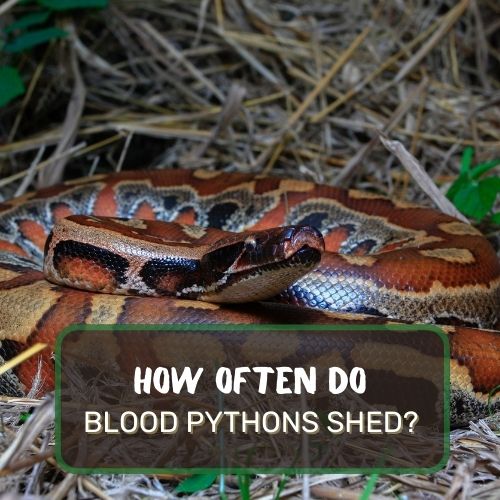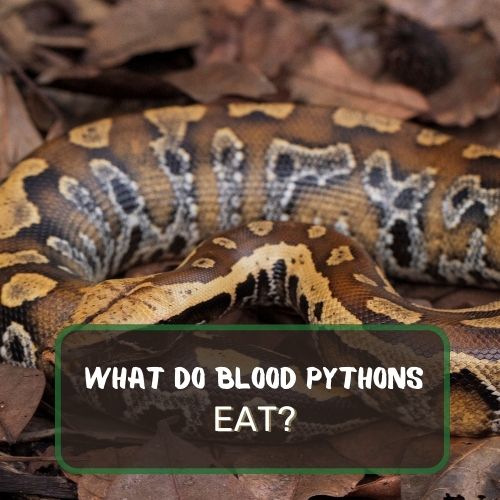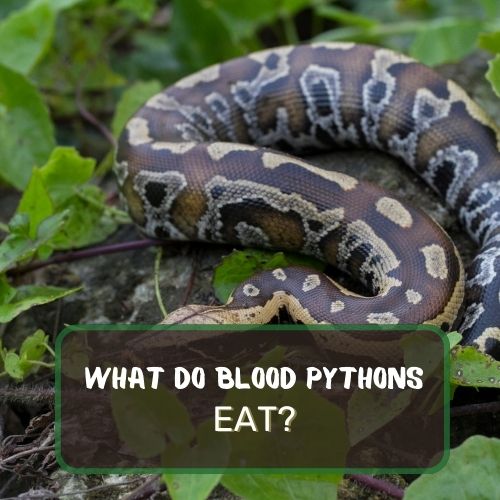Welcome to the fascinating world of Blood Pythons! In this article, we delve into the intriguing behavior of these captivating reptiles, particularly focusing on a common question: Do Blood Pythons burrow?
Blood pythons do not typically create deep burrows, but in their natural habitat, they exhibit burrowing-like behavior for camouflage and ambush. In captivity, they appreciate substrates that allow them to hide, reflecting their instinct for concealment and security.
We’ll explore their natural habitats and lifestyle, shedding light on how these factors influence their behavior in the wild and in captivity.
Additionally, we’ll guide you through creating an ideal enclosure to mimic their natural environment, discussing substrate preferences and the importance of burrowing accommodations.
Our comprehensive guide also includes a handy FAQ section, answering some of the most common queries about Blood Python care.
Get ready to uncover the secrets of these magnificent creatures!

Table of Contents
Do Blood Pythons Burrow? Examining Their Behavior in the Wild and Captivity
When we dive into the world of blood pythons, one question often slithers into the conversation: do these striking reptiles burrow? It’s not just a matter of curiosity; understanding this aspect of their behavior is crucial for anyone interested in providing the best care for these creatures, whether in captivity or in studying their wild counterparts.
In their natural habitat, blood pythons are known for being less active than some of their slithering kin. They aren’t the types to go on long, adventurous journeys. Instead, they prefer to stay put, waiting patiently for their next meal to wander by.
This behavior leads us to a fascinating trait – while they aren’t avid burrowers like some other snake species, blood pythons do exhibit burrowing-like behavior.
In the dense, leaf-littered floors of the marshy areas of Southeast Asia, they often find refuge under fallen debris and within the soft earth. This behavior is more about camouflage and ambush than creating extensive burrow systems. In captivity, this translates to a need for ample hiding spots.
Providing a substrate that allows for some degree of burrowing or hiding can make a significant difference in the wellbeing of these pythons. They might not create burrows per se, but they do appreciate the opportunity to nestle into a cozy, hidden nook, recreating the sense of security their natural environment offers.
Natural Habitat and Lifestyle
Blood pythons, with their robust and muscular bodies, hail from the humid and swampy realms of Southeast Asia. Think dense marshes, lush swamps, and the shadowy undergrowth of tropical forests in countries like Indonesia, Malaysia, and Thailand.
This environment is a far cry from open fields or desert landscapes; it’s a world where moisture clings to every leaf and the air hums with the sounds of hidden life.
In these habitats, blood pythons lead a lifestyle that’s quite different from what you might expect from such a seemingly formidable reptile. They are the embodiment of patience. Rather than actively hunting, they prefer to wait in ambush, often for hours or even days.
This patience is a testament to their adaptation to the dense, often limited visibility of their natural environment. They wait, hidden among the leaf litter or partially buried in the soft, damp earth, for unsuspecting prey to come within striking distance.
Their movement, while not particularly fast, is deliberate and efficient. You won’t find them racing or climbing trees; these ground-dwellers are all about conserving energy and striking with precision when the moment is right.
Understanding this behavior is key to providing an authentic and comfortable environment for blood pythons in captivity. By replicating these conditions – the humidity, the cover, the substrate – we can cater to their natural instincts and ensure their wellbeing, whether they’re in a terrarium or being studied in their natural habitats.
Importance of Burrowing and Hiding in Their Daily Life
The Need for Concealment
Blood pythons, in their native habitat, have developed a strong inclination towards concealment and protection, which is evident in their partial burrowing behavior. This isn’t just a random preference; it’s a critical survival strategy.
The dense forests and marshy areas they inhabit are teeming with both predators and prey. By staying hidden, they not only avoid becoming a meal for larger animals but also position themselves perfectly to ambush their next meal.
Stress Reduction in Captivity
When we translate this need for hiding into a captive environment, it becomes clear that providing opportunities for concealment is vital for their psychological wellbeing. A stressed snake is an unhappy snake, and in the case of blood pythons, stress often stems from feeling exposed.
Ensuring they have places to hide not only mimics their natural behavior but also reduces stress, leading to a healthier and more relaxed reptile.
Ideal Enclosure Design for Simulating Natural Habitat
Replicating the Dense Forest Floor
Creating an ideal enclosure for a blood python means thinking like one. Imagine the dense, humid floor of a Southeast Asian forest – this is what you’re aiming to replicate.
The enclosure should have a substrate that allows for some level of digging and hiding. Materials like coconut husk or cypress mulch can hold moisture well and provide the python with a semblance of its natural burrowing environment.
Incorporating Hiding Spots
In addition to the substrate, adding hiding spots is crucial. These can be in the form of hollow logs, bark pieces, or commercially available reptile hides.
The goal is to provide multiple options for the python to seclude itself, mimicking the natural debris and fallen foliage they would utilize in the wild. Remember, each hide should be snug; blood pythons feel more secure in tight spaces.
Ensuring Adequate Humidity and Temperature
Lastly, the enclosure must maintain the right humidity and temperature levels. Blood pythons are used to a humid environment, so maintaining a humidity level of around 60-70% is ideal.
Temperature gradients should also be established, with a warmer basking area and a cooler end to allow for thermoregulation, just as they would experience in their natural habitat.
Substrate Preferences and Burrowing Accommodations
Choosing the Right Substrate
The substrate in a blood python’s enclosure plays a pivotal role in their comfort and wellbeing. The ideal choice mimics the forest floor of their natural habitat, both in texture and function.
Cypress mulch, coconut husk, and aspen shavings are among the top choices. These substrates hold moisture well, aiding in maintaining the necessary humidity, and also allow for the python to engage in their natural burrowing-like behavior.
Facilitating Natural Behavior
Beyond just choosing the right material, the depth of the substrate is also crucial. A layer deep enough to allow the snake to partially bury itself or create shallow burrows can provide a sense of security and privacy.
This depth also helps in temperature regulation within the enclosure, an important aspect of recreating their natural environment.
Conclusion
As you now understand, Blood Pythons have unique behaviors that reflect their natural habitats. While they don’t burrow deeply, their need for hiding and security is paramount.
In creating a suitable home for them, it’s crucial to mimic these natural conditions. Remember, providing the right environment and care is not just about meeting their basic needs, but about enriching their lives.
So, as you embark on this journey with your Blood Python, embrace the opportunity to create a nurturing space that mirrors their natural world, and watch them thrive under your dedicated care.
FAQ
Do blood pythons need hides?
Absolutely. Hides are essential for blood pythons, providing them with a sense of security and a place to retreat. In the wild, these snakes often conceal themselves to avoid predators and ambush prey, so replicating this in captivity with suitable hides is crucial for their wellbeing.
What is the best bedding for a blood python?
The best bedding for a blood python would be one that holds moisture to maintain humidity, such as cypress mulch, coconut husk, or aspen shavings. These materials also allow the python to engage in its natural behavior of partial burrowing.
Where do pythons like to sleep?
Pythons typically prefer to sleep in secluded, secure areas. In the wild, this could be under logs, rocks, or within dense foliage. In captivity, providing hides or caves in their enclosure where they can retreat to and feel secure is important for mimicking their natural sleeping habits.
Do blood pythons like water?
While blood pythons are not aquatic snakes, they do appreciate access to water. They often soak in their water dishes, especially when they are about to shed their skin. Having a water dish large enough for them to fully immerse themselves is important in a blood python’s enclosure.




0 Comments